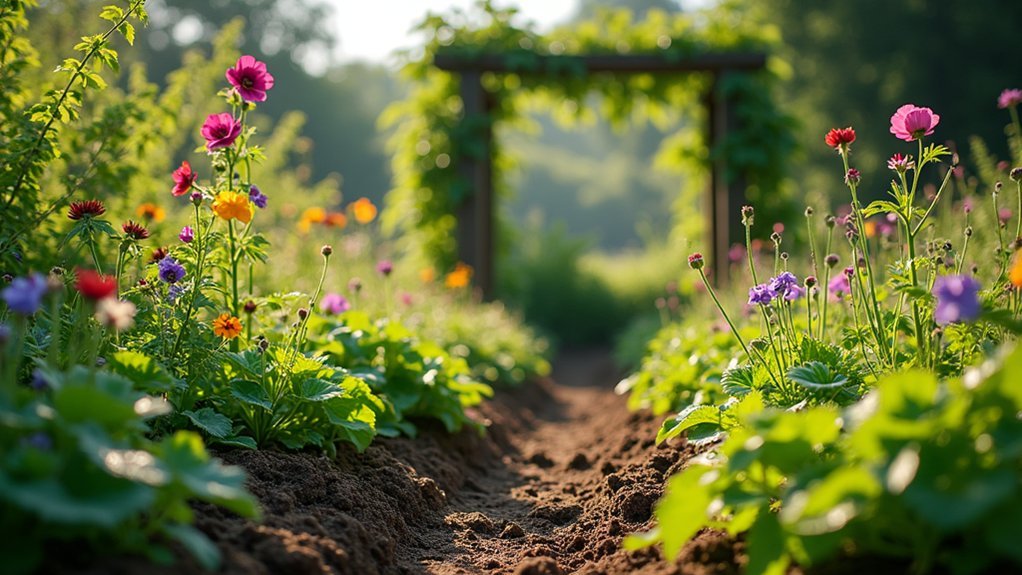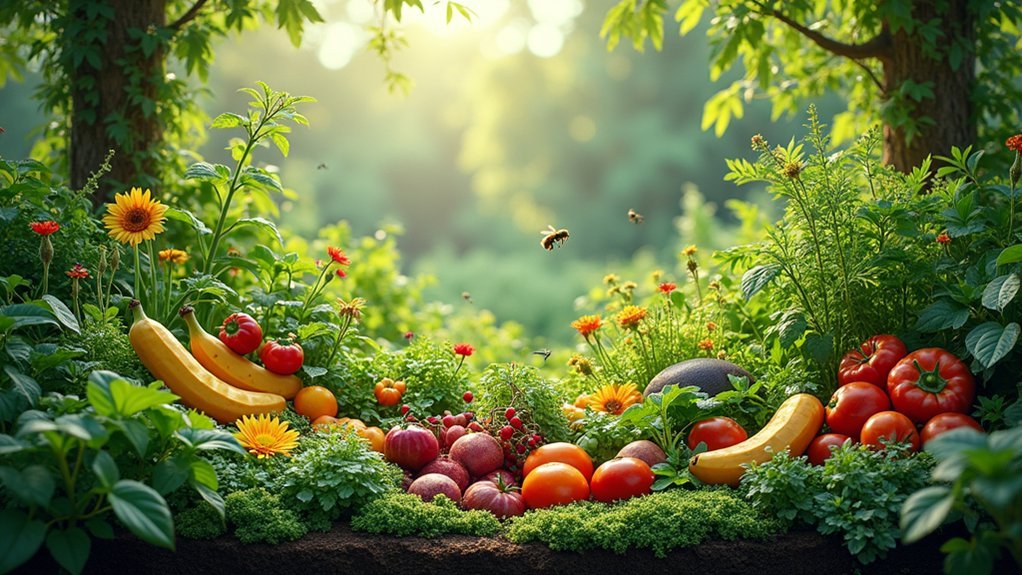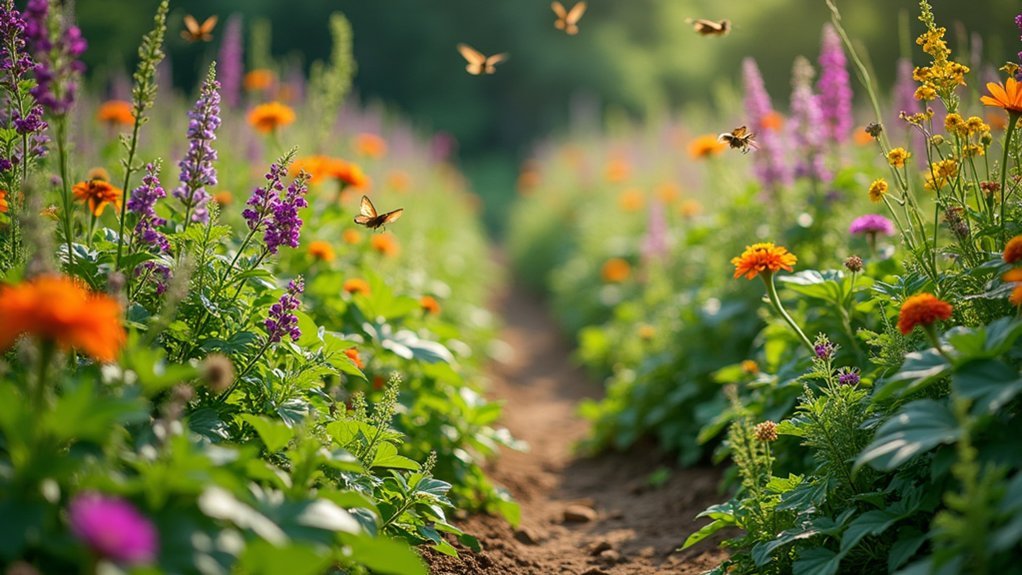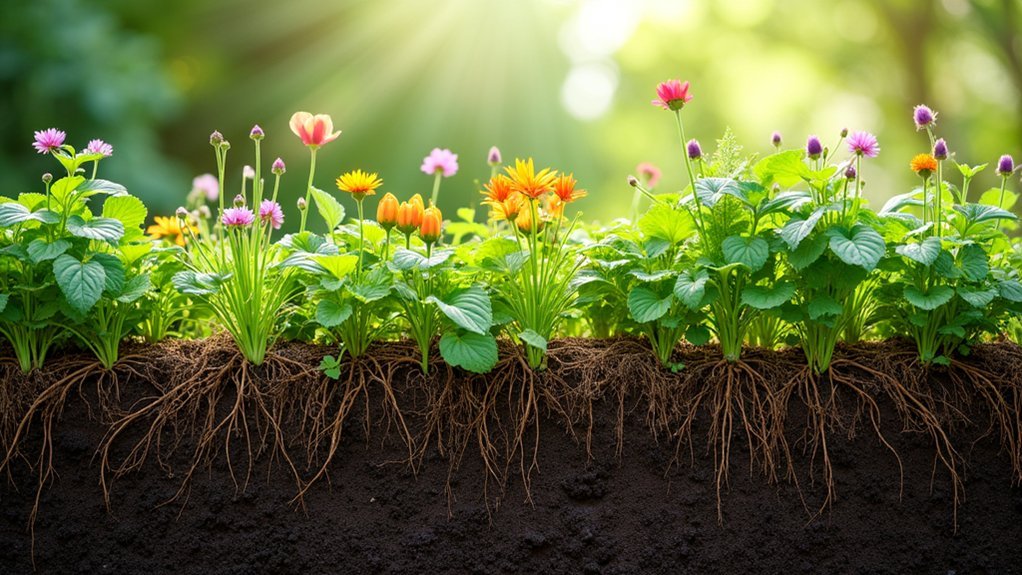Permaculture food borders transform your garden by mimicking natural woodland ecosystems, creating multifunctional spaces that go beyond conventional gardens. You’ll enjoy year-round harvests through vertical stacking while preventing erosion and building soil fertility without tilling. These living boundaries act as windbreaks, provide wildlife habitat, and naturally resist pests through diverse polycultures. Your garden edges become productive zones requiring minimal maintenance compared to traditional fencing, all while sequestering carbon and improving overall ecosystem health.
Why Permaculture Food Borders Transform Your Garden?

Five powerful transformations occur when you implement permaculture food borders in your garden.
These designed edges mimic woodland ecosystems, creating a vibrant tapestry of life that conventional gardens can’t match. Your soil regenerates naturally as perennial roots prevent erosion while organic matter continuously builds fertility without tillage. Creating diverse polycultures in your borders provides natural resistance against pests and diseases that typically plague monoculture plantings.
You’ll harvest food year-round as vertical stacking maximizes production in limited space.
Water efficiency dramatically improves through strategic plantings that capture rainfall and reduce irrigation needs. The microclimate created by your borders retains moisture even during dry periods.
Beyond environmental benefits, you’ll experience deeper connection to nature, reduced gardening costs, and greater self-sufficiency.
Your garden becomes both a productive food system and a living demonstration of sustainable principles in action.
The Living Fence Revolution: Beyond Ornamental Boundaries
Living fences represent perhaps the most revolutionary element of permaculture food borders, transforming ordinary boundaries into multifunctional ecosystems. When you replace traditional fencing with strategically selected plants, you’re not just marking property lines—you’re creating wildlife habitat, controlling erosion, and establishing natural pest management systems.
Your living fence delivers multiple benefits beyond aesthetics:
Permaculture’s living borders transform the mundane into the magnificent, delivering ecological function alongside boundary definition.
- Acts as windbreak and firebreak protection for your garden
- Provides additional yields: fodder, firewood, and medicinal resources
- Creates privacy while sequestering carbon and improving soil health
- Supports pollinators and beneficial insects that manage garden pests
- Requires minimal maintenance while outlasting conventional fencing materials
Many homeowners can implement the pleaching techniques to intertwine growing shrubs for a stronger, more resilient living barrier that withstands environmental pressures.
Edible Ecosystems: Creating Multi-Layered Food Borders

While living fences define your garden boundaries, multi-layered food borders transform these spaces into productive, resilient ecosystems that mimic nature’s inherent wisdom.
By designing in vertical layers—from canopy trees to ground covers—you’ll maximize both space and ecological relationships.
Your food border can incorporate fruit trees as sub-canopy elements, berries as shrubs, and herbs as ground cover. This structure creates habitat for beneficial insects while naturally controlling pests.
Each plant performs multiple functions: nitrogen-fixers improve soil, deep-rooted species access nutrients, and flowers attract pollinators. These plant relationships form balanced ecosystems that support each other while providing food and habitat for wildlife.
You’ll find these systems require minimal maintenance once established while delivering impressive harvests.
Their diversity makes them inherently adaptable to climate change, ensuring continued production despite weather fluctuations.
Microclimate Engineering Through Strategic Plant Placement
Every garden contains multiple microclimates—small pockets with unique temperature, moisture, and light conditions—that you can manipulate through strategic plant placement.
By understanding these variations, you’ll maximize growing potential and create resilient food borders that thrive despite challenging conditions.
Embrace microclimate diversity to transform garden challenges into opportunities for abundant, adaptable food systems.
Your permaculture food border can engineer beneficial microclimates by:
- Using tall plants as windbreaks to protect sensitive crops and extend growing seasons
- Placing heat-loving plants against south-facing walls that absorb and radiate thermal energy
- Creating moisture-retention zones with dense plantings in areas prone to drying
- Positioning shade-tolerant edibles beneath fruit trees to utilize vertical growing space
- Installing water features that moderate temperature extremes and increase humidity
This intentional design transforms ordinary gardens into productive ecosystems that work with nature rather than against it. Research shows that uniform plant layouts provide better cooling and ventilation compared to random arrangements, enhancing the overall microclimate regulation in your garden space.
Pollinator Highways: Designing Borders That Buzz With Life

Beyond microclimates, your permaculture border can serve as a vibrant pollinator highway, connecting fragmented habitats across your landscape.
These buzzing corridors provide essential food and shelter for bees, butterflies, and other beneficial insects while enhancing your garden’s productivity.
Select native, pollinator-friendly plants with varied bloom times to guarantee constant nectar sources.
Implement layered plantings that create diverse microhabitats for nesting and breeding.
You’ll find reduced maintenance needs through strategic design choices like hugelkultur, which improves soil health while minimizing watering.
Your pollinator highway delivers double benefits—ecological and economic. Observations from road trips show that areas deliberately seeded with wildflowers attract diverse insect species and contribute to ecosystem health.
While supporting biodiversity and soil health, you’ll enjoy improved crop yields through enhanced pollination services.
Plus, these vibrant borders create educational opportunities and aesthetic appeal, turning your garden into a community showcase for environmental stewardship.
Root-to-Fruit Planning: Maximizing Vertical Growing Space
Transforming your permaculture border into a three-dimensional growing system reveals tremendous potential in even the smallest spaces.
By thinking upward, you’ll create visually stunning gardens that produce more food while naturally deterring pests and reducing disease through improved airflow.
Your vertical garden borders can accommodate diverse plants from root to fruit:
- Train climbing vegetables like cucumbers and squash on trellises or supports
- Incorporate sweet potatoes and carrots in specialized vertical systems
- Mix in herbs at mid-levels for easy access and continuous harvesting
- Add flowers to attract beneficial insects and enhance beauty
- Use repurposed materials like pallets or PVC pipes to create cost-effective structures
Practicing vertical gardening allows your fruits and vegetables to grow healthier and productive as they remain elevated away from ground-dwelling pests and soil pathogens.
This approach not only maximizes sunlight exposure but also conserves water and simplifies maintenance—making your permaculture borders more productive and sustainable.
Four-Season Harvests From Your Garden Perimeter

While vertical systems maximize your growing space, the true magic of permaculture borders reveals itself when they produce food year-round. By implementing succession planting and season extension techniques, you’ll enjoy fresh harvests in every season. Utilizing hardy leafy greens like kale, lettuce, mache, and collards ensures continued production even during colder months.
| Season | Best Plants | Protection Method |
|---|---|---|
| Spring | Leafy greens, peas | Low tunnels |
| Summer | Tomatoes, peppers | Natural shade |
| Winter | Root vegetables | Cold frames |
Adapt Eliot Coleman’s two-layer hoop house design using recycled materials to protect crops from harsh weather. You’ll greatly reduce grocery bills while decreasing your carbon footprint. Enhance soil thermal mass through mulching and composting to maintain warmth during colder months. Your garden’s perimeter becomes a resilient food production zone that works with your local climate rather than against it.
Natural Pest Management Through Companion Planting
Rather than reaching for chemical pesticides when bugs invade your garden, permaculture borders can establish natural defense systems through strategic plant partnerships.
These plant allies work together to confuse, repel, or trap pests while attracting beneficial insects that devour unwanted visitors.
Nature’s clever alliance: plants that confuse pests while recruiting their natural predators to guard your garden.
- Strong-aroma herbs like basil and oregano mask crop scents and actively repel common garden pests.
- Trap crops such as nasturtiums and sunflowers lure insects away from your valuable vegetables.
- Sweet alyssum, yarrow, and carrot-family blooms attract beneficial predatory insects that hunt pests.
- Intercropping tomatoes with garlic or broccoli with nasturtiums creates confusion for specialized pests.
- Structural repellents like petunias physically trap pests, while sage and thyme emit pest-deterring compounds.
You’ll find these companion planting strategies create a self-regulating ecosystem that reduces maintenance while improving harvests. Creating increased plant diversity helps significantly reduce pest populations naturally without resorting to chemical interventions.
Self-Fertilizing Systems: Nutrient Cycling In Border Designs

Beyond pest management, permaculture food borders truly shine in their ability to fertilize themselves.
You’ll witness nature’s elegant recycling system in action as fallen leaves and plant matter decompose, continuously enriching your soil without added fertilizers.
The magic happens when you incorporate nitrogen-fixing plants alongside deep-rooted species. This approach follows the essential permaculture principle of utilizing natural resources efficiently to create sustainable, low-maintenance gardens.
These botanical workhorses pull nutrients from the atmosphere and deep soil layers, making them available to neighboring plants.
Meanwhile, mycorrhizal fungi form underground networks connecting your plants, enhancing nutrient exchange throughout the border.
Water-Wise Border Construction For Drought Resilience
You’ll maximize water efficiency in your food borders by installing contour-aligned swales that capture rainfall and slowly release it into your growing zones.
Combine these water-harvesting earthworks with drought-resistant plant guilds featuring deep-rooted perennials like comfrey alongside silver-foliaged plants that reduce transpiration.
For enhanced resilience, incorporate 4-6 inches of organic mulch between your plantings to dramatically reduce evaporation while suppressing weeds. This approach creates rich organic matter that transforms your soil into a moisture-retaining sponge, significantly improving your garden’s drought resilience.
Swales Capture Rainfall
When strategically integrated into permaculture food borders, swales become powerful rainwater harvesting systems that transform potentially destructive runoff into a valuable resource.
These shallow, contour-aligned channels work silently to build resilience against drought while supporting vibrant ecosystems.
Your swales will provide multiple benefits:
- Slow water movement across your landscape, allowing deep soil infiltration rather than wasteful runoff
- Create perfect conditions for mycorrhizal networks that boost plant nutrient uptake during dry periods
- Reduce irrigation needs by storing rainwater directly in your soil’s “bank account”
- Buffer temperature extremes through increased humidity and vegetation
- Support biodiversity with moisture-rich habitat zones for beneficial insects and pollinators
Constructing berms alongside your swales helps to effectively direct rainwater into these channels, maximizing water capture and retention.
For maximum effectiveness, incorporate deep-rooted native plants along edges and maintain a minimum 1% slope to prevent stagnation.
Drought-Resistant Plant Guilds
Four essential principles guide the creation of drought-resistant plant guilds that thrive in challenging conditions while minimizing water usage.
First, prioritize perennial plants with deep taproots like comfrey and yarrow that access subsoil moisture.
Second, incorporate nitrogen-fixing legumes such as cowpeas and white clover to improve soil fertility naturally.
Your guild structure should include strategic shade layering, using taller plants like sorghum to protect soil moisture for understory species.
Position drought-tolerant plants at canopy drip-lines to maximize rainwater capture.
Select multi-functional species that simultaneously provide mulch, pest control, and nutrition—plants like dandelions mine nutrients from deep soil layers while bee balm attracts pollinators despite arid conditions. Incorporating several beneficial insect attractors helps maintain natural pest control within your drought-resistant guild.
For successful implementation, allow at least 6m² for each plant community and focus irrigation only during establishment phases.
From Bare Fence To Food Forest: Transformation Timeline
Transforming a bare fence into a thriving food forest follows a natural progression from foundational groundwork to abundant harvest.
You’ll see dramatic changes in the first year as pioneer species establish roots and begin building soil fertility, followed by a middle-stage where productive plants mature and guilds develop complex relationships.
Creating effective water management systems during the foundational phase ensures your plants will thrive through seasonal challenges while minimizing your water bill.
First Year Foundational Growth
The journey from bare fence to vibrant food forest begins with intensive preparation and thoughtful design during the essential first year. Your soil becomes the canvas for transformation through sheet mulching and biochar application, creating a microbial wonderland beneath the surface.
Start by mapping microclimates along your fence line, identifying where sun exposure and water patterns create natural planting zones.
Then establish your foundational elements:
- Plant nitrogen-fixing pioneers like fava beans and clover to jumpstart soil fertility
- Install swales and berms to capture precious rainwater where it’s needed most
- Introduce dynamic accumulators like comfrey to mine deep nutrients
- Establish nurse trees as windbreaks to protect sensitive saplings
- Seed self-sowing annuals for immediate pollinator support while perennials establish
This foundational approach mimics the stability of natural ecosystems while providing ecological benefits similar to forests without requiring fertilizers or excessive maintenance.
Middle-Stage Productive Maturation
As your first-year foundation takes root, your border garden enters its most dynamic phase: the middle-stage maturation period.
You’ll witness soil-building shift from initial composting to self-replicating biomass systems as nitrogen-fixing shrubs and perennials take over.
During these 5-15 years, your mid-canopy shrubs and bush layers dominate, creating stable microclimates before full canopy closure.
You’ll harvest medicinal herbs, edible greens, and nitrogen-fixers while waiting for tree crops to mature.
Your management strategy evolves too—targeted pruning replaces weeding as plant guilds naturally suppress invaders through shade and root competition.
Use short-lived nurse species like Acacia to protect slower-growing perennials during establishment.
Layered plant “consortiums” optimize spaces based on microclimate variables, while staggered flowering guarantees constant pollinator support and thermal regulation throughout your evolving food border.
This phase requires consistent observation and adaptation as your system develops, documenting which plants thrive or struggle to inform future planting decisions.
Full Forest Succession
From bare fence to thriving food forest, your permaculture border follows a predictable succession pattern spanning decades. Understanding this natural progression helps you work with nature rather than against it.
Your border will evolve through distinct phases:
- Stand Initiation (0-15 years): Pioneering weeds give way to early productive plants.
- Grass-Shrub Community (3-18 years): Diverse shrubs emerge as sunlight penetration decreases.
- Young Forest (19-30 years): Productive trees establish dominance with understory development.
- Mature Forest (30-70 years): Complex layering develops with maximum yield diversity.
- Climax System (70+ years): Self-sustaining oak-hickory dominated ecosystem emerges.
Perennial Power: Low-Maintenance Edible Border Solutions
While traditional gardens demand constant attention, perennial edibles offer a revolutionary approach to border design that minimizes effort while maximizing returns.
Their deep root systems require minimal watering once established and naturally improve soil structure over time.
You’ll appreciate how these plants create self-sustaining ecosystems that cycle nutrients naturally, reducing or eliminating the need for synthetic fertilizers.
Many herbs like chives and oregano naturally suppress weeds, further cutting your maintenance time.
For visual appeal, combine functional harvests with beauty using basil, lavender, and edible flowers like nasturtiums.
Group plants strategically by water needs and mature sizes to prevent overcrowding.
Consider blueberries for marginal spaces with shallow soil, and use asparagus ferns for decorative contrast while providing delicious spring harvests.
Space-Saving Techniques For Small Garden Boundaries
Small garden boundaries can be transformed into productive growing areas with vertical systems that maximize your limited space.
You’ll find that wall-mounted planters, trellises, and hanging baskets create multiple growing planes while preserving precious ground space.
Vertical Growing Systems
When space constraints limit your gardening ambitions, vertical growing systems offer an ingenious solution for maximizing productivity in confined areas.
These space-efficient designs transform boundary walls and fences into thriving food production zones without sacrificing your limited garden footprint.
- Hydroponic towers with spiral planting ports allow you to grow leafy greens and herbs without soil.
- Stackable containers create multi-tiered planting opportunities, perfect for strawberries and compact vegetables.
- Self-watering systems with internal reservoirs reduce maintenance to just 5 minutes weekly.
- LED grow lights extend growing seasons and enhance plant growth in shaded boundary areas.
- Water-recycling features conserve resources, with systems like Tower Garden reusing 100% of water and nutrients.
You’ll enjoy both abundant harvests and environmental benefits, including reduced carbon footprint and support for local food production.
Edge Maximization Strategies
In permaculture design, the most productive areas often exist where ecosystems meet, creating what gardeners call the “edge effect.”
You’ll dramatically increase your garden’s productivity by strategically designing boundaries that maximize these edge zones.
Replace straight-lined borders with meandering paths and curved garden beds to multiply your productive space.
Implement keyhole designs that improve plant access while fostering biodiversity.
For small gardens, try herb spirals—these ingenious structures create multiple microclimates within a compact area.
Offset your planting patterns rather than placing everything in rigid rows.
This uneven approach forms natural plant guilds where species support each other.
Frequently Asked Questions
How Do Permaculture Borders Affect Property Values and Neighbor Relations?
Permaculture borders can increase your property’s value through improved aesthetics and functionality. You’ll build better neighbor relationships through shared harvests and privacy benefits, though some may resist unfamiliar planting styles.
Can Permaculture Borders Work in Extreme Climates or Urban Apartments?
Yes, you’ll find permaculture borders adapt well to extreme climates through microclimate creation and resilient planting strategies. In urban apartments, you can implement vertical gardens, container systems, and balcony designs with surprising success.
What Are Startup Costs Compared to Traditional Landscaping?
You’ll initially spend more on permaculture borders than traditional landscaping—around $20-40K per acre versus typical landscaping costs. However, you’re investing in self-sustaining systems that’ll reduce your long-term maintenance expenses considerably.
How Do Permaculture Borders Interact With Existing Utility Lines?
Permaculture borders require careful planning around utility lines. You’ll need to identify underground utilities, use shallow-rooted plants near them, and maintain access points for repairs. They can beautify these often neglected spaces while ensuring safety.
Are There Permaculture Border Plants Safe for Households With Pets?
Yes, you can create pet-safe permaculture borders using non-toxic plants like thornless roses, zinnias, Dutch clover, and ferns. Incorporate raised beds or decorative fencing to protect sensitive plantings from curious paws and playful pets.
In Summary
You’re now ready to transform your garden’s borders into productive permaculture zones. By layering edible plants, creating microclimates, and supporting pollinators, you’ll build resilient boundaries that work with nature, not against it. Don’t wait for the perfect moment—start small, expand gradually, and watch as your ordinary garden edges evolve into thriving food ecosystems that nourish both you and the environment.





Leave a Reply